Lesson 2A
Visiting Hùng Vương era cultural heritage
The beliefs and custom of the Hùng Vương era that are still practiced up to the present are:
– Worship of gods
– Mẫu Cult (Worship of Mother Goddesses)
– Bánh Chưng bánh dầy rice cakes
– Betel and areca, tooth lacquering
– The skirt
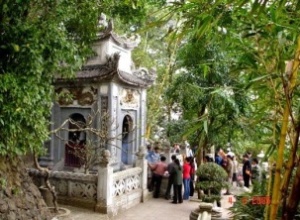
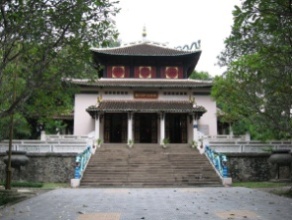
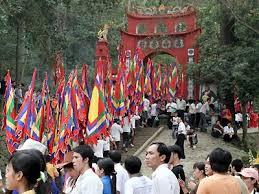
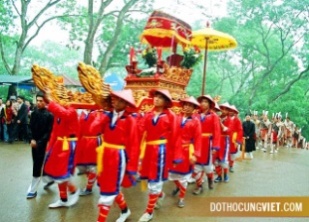
Relic from Hùng Vương era Hùng Vương Temple Hùng Vương Festival
Worship of gods
Worship of gods[1] was the Vietnamese people’s oldest specific pre-Buddhism belief that still remains in the present day because the Vietnamese people believe that, after death, the soul survives in the other world. For example, they still worship deities-national heroes such as Phù Đổng Thiên Vương, Chữ Đồng Tử, Tản Viên.
In the province of Bắc Ninh, the worship of Tứ Pháp (four Goddesses of: Cloud, Rain, Thunder, Lightning) can still be seen at the four pagodas (used to be temples): Dâu Pagoda for Pháp Vân (Goddess of Cloud), Đậu Pagoda for Pháp Vũ (Goddess of Rain), Tướng Pagoda for Pháp Lôi (Goddess of Thunder), Dàn Pagoda for Pháp Điện (Goddess of Lightning). All these four pagodas in the Province of Bắc Ninh were built in the III century, located in the Dâu region, which had been named Luy Lâu during the period of Chinese domination.
Mẫu Cult (Worship of Mother Goddesses)
Before 1985, the Mẫu Cult[2], with these medium sessions, was forbidden by the Communist government and was allowed again after it was recognized by UNESCO as the original traditional belief of the Vietnamese people that had existed since pre-historic time.
Among the beliefs from the Hùng Vương era that are still currently practiced only Mẫu Cult, with medium sessions, has followed the exodus of the Vietnamese refugees to overseas.
In 1954, the Mutual Aid Society of North Vietnam of the “Tonkinese refugees” brought Mẫu Cult to Saigon and organized the worship at Phủ Giày Vọng Từ temple built in Gia Định.
After the 1975 political event, it was also these same “Tonkinese refugees” who “emigrated” all the Mẫu to overseas, for example, the Mẫu temple at 6681 Chabot Street in Montreal, Canada[3],.the temple for Mẫu and Đức Thánh Trần on Emmora Lane, in Houston, United States. For the Mẫu temple in France, you can read the book by Simon, P.J and Simon-Barouth[4].
Heritage from Hùng Vương era
Mẫu Cult is organized into Tam Phủ (Three Palaces), Tứ Phủ (Four Palaces), each Phủ is presided over by a goddess, i.e. Mẫu (Mother Goddess). Under each Phủ, there are:
– Ngũ vị quan lớn (The Five Great Officials)
– Tứ vị chầu bà (The Four Avatars of the Four Mẫu)
– Ngũ vị hoàng tử (The Five Princes)
– Thập nhị vương cô (The Twelve Maidens)
-Thập vị vương cậu (The Ten Lads)
– Ngũ hổ (The Five Tigers)
– Ông Lốt (The Sacred Serpent, or Naga)
Among the four Mẫu, there are two who have been originated from the Hùng Vương era. They are:
– Mẫu Thượng Ngàn (Highlands Goddess) (green), a princess of the Hùng Vương era and responsible for the protection of the forest;
– Mẫu Thoải (Water Goddess) (the word Thoải is a variation of the word Thủy = Water) (white), daughter of Long Vương (Dragon King) from Động Đình Hồ (Tung Ting Hu or Dongting Lake, a large lake in Northeast of Hunan Province).
Rituals of Mẫu Cult: medium session and attendance
Lên đồng (Mounting the medium): the god or spirit mounts the body of the medium,
Hầu bóng (Receiving incarnations of the deities): bóng means the incarnation of the deity, and hầu means attending / serving. Hầu bóng is the popular spiritual stage accompanied by music, musicians, dancing, and distribution of good fortune.
The master of ceremony is Bà đồng, principally responsible for the re-appearance of the legend and activities of the gods or goddesses.
The participants are the disciples, the followers, who have come to ask the deities for protection in their daily life, for their good fortune, or just for some guidance…
The mediums in these sessions are collectively called Thanh đồng nam (or cậu = lad) for the boys, and Thanh đồng nữ (or cô = maiden) for the girls. There are usually 2 or 4 Phụ đồng (assistant helpers, also called nhị trụ or tứ trụ hầu dâng), who accompany the Thanh đồng and help them in the arrangement of the ceremony, clothing…
During one medium session there are quite a few “giá = séances.” Before going into a new séance, a red silk cloth is used to cover up the medium. When the cloth is removed, the medium is now in a new séance and has the change clothes and other accessories to fit into the new séance. The rituals for the incarnations of the deities must follow the up to down order, from Mother Goddess, to Officials, to Ladies, to Princes, and to maidens and lads.
The practice of Mẫu Cult has essentially been oral and witnessed from people to people, and thus, there has been no need of a religious philosophy or explanation in the natural feeling about the deities. In essence, the Mother Goddesses are protectors for health, good fortune of people. They also are receivers of wishes, aspirations about the earthly life (money, health, good fortune, positions in society), and they represent the opportunity for harmonious man-god relationships. It is the ritual for the interface with the deities through the male or female mediums. The disciples and followers believe that the deities mounting the bodies of the mediums will provide them with guidance, get rid of bad spirits, cure sicknesses, and distribute happiness and good fortune. During the session, the medium is the deity. When we participated in the medium session at 6681 Chabot Street in Montreal[5], we all felt that the deity and the followers were really creating an atmosphere of spiritual sympathy and empathy.
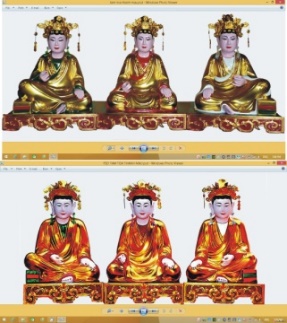
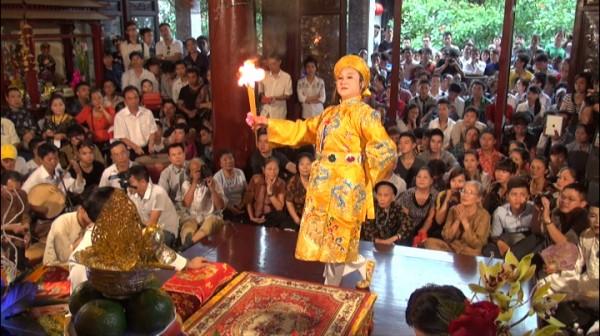
Statues of Mother-Goddesses of Three Palaces Medium session: Session of The Prince
The Story of Betel and areca
In our journey of field trips in our homeland, you will be able to observe a South East Asian cultural characteristic of the Hùng Vương era, which has survived until today, and that is the custom of betel chewing. The betel and areca did not exist in China. The Chinese, therefore, had to transcribe phonetically the South East Asian word for the areca and called it bin lang, which was pronounced tân lang in Sino-Vietnamese. Bin lang was a word in the ancient Vietnamese language, just like the the Rade people’s word pnang or mnang and the Mường’s word nang for the areca[6].
The custom of betel chewing at wedding ceremonies, guest receptions was recorded in Nam châu bát quận chỉ (Gazetteer of the eight-districted Southern Land) and Nam phương thảo mộc trạng (State of the flora of the Southern Land) (III century) and was explained in a legend under the reign of Hung Vương the Fourth[7]..
From that time on, in the cultural life of the Vietnamese people, the story of betel and areca implied a non-verbal philosophy of matrimonial relationship, and of social relationships such as friendship, weddings, ceremonies, celebrations, anniversaries…
The accessories used in betel chewing are the small areca-cutting knife, the tray for betel display, the lime-containing vase, the betel grinder (for old people), and the spittoon.
There are several species of betel: trầu quế (cinnamon betel), trầu hồi (clove betel), trầu cay (hot betel), trầu hôi (smelly betel); for areca we have cau tươi (fresh areca), cau non (young areca), cau già (mature areca), cau khô (dried areca)[8].
Đầu rồng đuôi phượng te te,
(With a dragon head and a radiant phoenix tail)
Mùa đông ấp trứng, mùa hè nở con.
(Incubinating eggs during winter time, and hatching younglings in summer time)
Each portion for betel chewing is of one green betel leaf, with a thin layer of lime on its surface, one piece of areca, and one thin slice of the shorea guiso bark. This portion for betel chewing gives a combination of many different flavours: sweet from the areca, fragrant from the betel leaf, acrid from the bark, and hot from the lime. This mixture creates a feeling of warmth, a little dizziness, drunkenness caused by the nerve-arousing arecoline from the areca nut. With cinnamon, tobacco added, the whole mixture will increase the drunkenness, making people feel warm, with both cheeks becoming pink, more attractive, the conversation more open, the whole body more relaxed with increased blood circulation.
In order to have a delicious portion for betel chewing, people have to know where to go to get it, for example, for women living in Huế:
Buying the lime at Quán market or Cầu market
Buying areca from Nam Phổ, buying betel leaves at Dinh market
With Dinh market betel leaves and Nam Phổ areca
The mixture will be red even if the lime is young and still delicious even if the bark is missing.


Portion for betel Tray of betel-areca
Flavour and taste of betel
To chew betel is to enjoy the combined flavour of fragrant from the betel leaf, of acrid from the bark, of sweet from the areca, and hot from the lime… all are mixed to produce the dark- red juice:
Separated, it’s bitter, it’s hot
Put together, it’s sweet, and it’s exciting.
Separated, the leaf is green, the lime is white
Put together, it surprisingly becomes bloody red.
Redness: symbol of conjugal relationship
The betel chewing mixture produces a bright red juice. The redness of the betel juice (quít trầu[9]) is the symbol for the long-lasting conjugal relationship.
Có phải duyên nhau thì thắm lại
(If we are to be together please turn into red)
Đừng xanh như lá, bạc như vôi
(Don’t be green like the leaf, or white like the lime)
(Hồ Xuân Hương’s poem)
Preparing the betel portion
To prepare the betel portion is an artful skill in order to achieve different shapes, such as the ant wing, or the cinnamon wing, or the spear tip. The preparation of the betel portion bears the regional cultural mark, for example, the preparation of the phoenix wing betel portion symbolizes the country-girl of Kinh Bắc. In this preparation style, the areca is carved in bas-relief, the chosen cinnamon betel leaf is trimmed into the phoenix wing shape, and a rather thick piece of shorea guiso bark (plus some rose petals) is used to create the tail of the phoenix. This phoenix wing betel portion will be displayed on the decorative plate, or the areca is pierced on the tip of a 20 cm long bamboo stick plugged into a crystal vase or glass (containing rice).
This artful phoenix wing betel portion preparation style reminds people of the legend of Tấm Cám, in which the prince, in his travel, stopped by a road-side tea stall and was served by the old-lady owner with this phoenix wing betel portion. The prince recognized right away this betel preparation style which had been served by his wife before. Thanks to that he was finally reunited with his wife, Tấm.
Trầu têm cánh phượng xinh xinh,
(The phoenix wing betel portion is beautiful)
Chờ trao cho thắm môi mình, lòng say.
(Waiting to be served to redden your lips and to get yourself excited)


Phoenix wing betel portion Betel tray
The language of betel-areca in wedding ceremony
The tray of betel-areca has always been a conventional offering symbolizing a beautiful cultural trait from pre-historic time. In different ceremonial stages of a marriage, such as proposal, pre-engagement, engagement, and finally wedding, a mandatory ceremony in both old and modern times to be performed by the groom’s family is to bring a tray of betel-areca to the bride’s house, and accepting the betel-areca tray is the super-language of the bride’s family for approval of the marriage. According to Trương Ngọc Tường, a cultural researcher from Tiền Giang province, the ceremonial tray of betel-areca used in engagement and/or wedding ceremony is a square tray called “khay trầu rượu = tray of betel and alcohol” and containing two boxes, the larger one representing the husband, the smaller one for the wife, and also two small bowls. In the pre-engagement ceremony in North Vietnam, the offerings are a few packages of tea, a couple of alcohol bottles, a branch of areca, a stack of betel leaves (must be an even number). In the South, the offerings include tea and alcohol, cakes and sweets, one tray containing two small bowls of alcohol, one alcohol decanter, and 4 prepared betel portions to be offered to the bride’s parents.
The offerings for the engagement ceremony comprise betel-areca, alcohol and tea, and a pair of candles for the ritual on the ancestral altar. The bride’s family will make the distribution of betel-areca and cakes-sweets to the relatives.
A tray of betel-areca consists of a bunch of 105 young areca nuts representing a one-hundred-year happiness or 60 nuts following the common saying for 60-year happy life; each areca nut is paired with 2 green betel leaves still having the petioles, which symbolize the married couple.
Language of social relationship
In the daily social exchanges, “Miếng trầu là đầu câu chuyện = A betel portion is the beginning of a conversation” goes hand in hand with the salutation, welcoming a guest. The people in the old times, therefore, always travelled with a package containing betel-areca; so that they could make an offer to people they met. That was the special traditional manifestation of social exchange of the Vietnamese people from Hùng Vương era.
Gặp đây ăn một miếng trầu,
(Meeting here let’s have a betel portion,)
Chẳng ăn cầm lấy cho anh bằng lòng.
(If you don’t chew, please still take it to make me happy.)
Xưa kia có biết ai đâu,
(In the past, we did not know anybody,)
Chỉ vì điếu thuốc, miếng trầu nên quen.
(Thanks to a cigarette, a betel portion, we are now acquaintances.)
Gặp nhau ăn một miếng trầu,
(We met and we shared a betel portion,)
Gọi là chút nghĩa về sau mà chào.
(We started a relationship and thence a salutation.)
Từ ngày ăn miếng trầu anh,
(From the day I chewed the betel portion you offered,)
Cho nên má đỏ, tóc xanh đến giờ.
(My cheeks have become red and my hair green up to now.)
Miếng trầu ăn nặng bằng chì,
(The betel I chewed weighed like lead,)
Ăn rồi em biết lấy gì đền anh.
(Your offer taken, how could I make it up to you?)
Language of the betel portion preparation
In the old days, when coming to take a look at the bride, the groom’s family always asked to see the way the bride prepared the betel portion in order to assess her behaviour and her characters, and from that to evaluate her family education. A look at the betel portion would help them to know her characters: simple or complicated, warm or frigid by looking at the amount of lime spread on the betel leaf (too much lime showing that she is a wasteful person), too much cinnamon or too much fragrant, the small betel leaf with a big piece of areca (a person who is not good in calculation).
Language in declaring love
The betel portion is a declaration of love by
Vào vườn hái quả cau tươi,
(Going into the garden and pick a fresh areca nut,)
Bổ ra làm sáu mời anh xơi trầu.
(Cutting it into six pieces to offer you the betel portion.)
The girl then offers the betel portion with this secret thought:
Trầu này trầu tính, trầu tình,
(This betel portion I offer you with my love,)
Ăn vào cho đỏ môi mình, môi ta.
(Chewing it will redden your lips and my lips.)
Trầu này trầu tính, trầu tình,
(The betel portion I offer you with my love,)
Trầu loan, trầu phượng, trầu mình lấy ta.
(That’s male phoenix betel, female phoenix betel, that’s your betel to marry me.)
Betel of conjugal relationship
The betel portion must consist of a betel leaf with lime spread on it and a piece of fresh areca nut. The whole mixture will produce a juice that is hot, fragrant, and red symbolizing the conjugal relationship.
Trầu này thực của em têm,
(This betel portion is really prepared by me,)
Trầu phú, trầu quí, trầu nên vợ chồng.
(It’s the precious betel that makes us husband and wife.)
Trầu này bọc khăn tơ hồng,
(This betel is covered by the pink wedding cloth,)
Trầu này kết nghĩa loan phòng từ đây.
(This betel unites us in the conjugal relationship from now on.)
Miếng trầu ăn kết làm đôi,
(The betel portion that we chew turns us into a married couple,)
Lá trầu là vợ, cau tươi là chồng.
(The betel leaf is the wife, the fresh areca is the husband.)
Betel of friendship, betel of love
“Khẩu trầu dải yếm” is the prepared betel portion being kept within the girl’s brassiere and offered to her lover.
When the boy she likes comes for a visit, the girl will offer a betel portion to start a conversation.
Trầu em têm tối hôm qua,
(This betel portion was prepared by me just last night,)
Cất trong dải yếm mở ra mời chàng.
(I kept it in my brassiere and now I offer it to you.)
The girl has three kinds of betels: trầu túi (betel kept in pocket), trầu khăn (betel kept in towel), and trầu dải yếm (kept in brassiere), and she asks the boy:
Trầu này trầu túi, trầu khăn,
(These betels, betel kept in pocket, betel kept in towel,)
Cùng trầu dải yếm, anh ăn trầu nào?
(And betel in brassiere, which one would you choose?)
If the boy chooses the betel in pocket or the betel in towel he implies that he is just a friend. If he chooses the betel in brassiere he means he wants to be her lover and wishes to marry her. The girl will then get the betel portion she kept in her brassiere to offer him. After the boy enjoys that betel portion she will ask:
Trầu em buộc dải yếm đào,
(My betel portion was attached to my red silk brassiere,)
Hởi người tri kỷ ăn vào có say?
(My dear love, do you feel drunk after you chewed it?)
Từ ngày ăn phải miếng trầu,
(From the day I chewed that betel portion,)
Miệng ăn môi đỏ, dạ sầu đăm chiêu.
(My lips all become red, and I felt a little melancholy.)
Một thương, hai nhớ, ba sầu,
(One for love, two for miss, three for melancholy,)
Cơm ăn chẳng được, ăn trầu cầm hơi.
(I can’t eat rice, I chew betel to keep on living.)
Sentimental language of betel of love, betel of dislike
When the boy offers betel and the girl refuses, he scolds:
Đi đâu cho đổ mồ hôi,
(Where do you go and sweat like this,)
Chiếu trải không ngồi, không để không ăn.
(The mat already spread and you don’t sit, the betel is prepared and you don’t chew).
This is important for the girl because if she accepts the betel it means that she accepts his love declaration according to the non-verbal philosophy of betel chewing.
Thưa rằng bác mẹ tôi răn,
(Yes, my parents have taught me that)
Làm thân con gái chớ ăn trầu người.
(A girl should not take the betel offered by strangers.)
Miếng trầu ăn nặng bằng chì,
(The betel I chewed weighed like lead,)
Ăn rồi em biết lấy gì đền anh.
(Your offer taken, how could I make it up to you?)
The feelings of love or hate will be expressed by the areca cutting.
Yêu nhau cau sáu bổ ba,
(When you love, you cut into three pieces an areca for six pieces)
Ghét nhau cau saú bổ ra làm mười.
(When you hate, you cut into ten pieces an areca for six pieces.)
Also, poets usually employ the betel-areca theme in their love poems.
Thôn Đoài ngồi nhớ thôn Đông,
(Sitting here in West village and missing someone in East village,)
Cau thôn Đoài nhớ trầu không thôn nào?
(Areca of West village misses betel of which village?)
(Poem by Nguyễn Bính)
For two persons who love each other and cannot get married, the tragedy is as follows.
Có trầu, có vỏ, không vôi,
(Here is betel leaf, here is bark, but without lime,)
Có chăn, có chiếu, không người nằm chung.
(Here is blanket, here is mat, but there is no one to lie down with.)
Yêu nhau chẳng lấy được nhau,
(Loving each other but cannot get married,)
Con lợn bỏ đói, buồng cau bỏ già.
(The pig is left to starve, and the bunch of areca nuts is left to harden.).
Bánh chưng, Bánh dầy rice cakes
Dù ai buôn bán đâu xa,
(Whereever and how far away you conduct your business,)
Năm năm nhớ lấy tháng Ba mồng mười.
(Every year you must remember the tenth day of the Third month.)
(Anniversary Date of our Ancestor Hùng Vương)
Currently living overseas, we still keep our tradition of celebrating the anniversary date of our ancestor with bánh chưng bánh dầy rice cakes inherited from Hùng Vương era. The legend of bánh chưng bánh dầy rice cakes is told as follows:
“Under the reign of Hùng Vương The Sixth, after our victory against the Ân invaders, the King, wanting to abdicate in favour of one of his sons, convened his twenty-two sons (Quan Lang) and said: My sons, whoever find the best food to offer at the year-end anniversary celebration for my Predecessor and at the same time to be able to display fully our filial piety will inherit this throne from me.
His sons competed one another to find that desired food. The eighteenth son, Tiết Liệu, having lost his mother at early age, was alone without anybody’s help, worried days and nights, not knowing what to do. One night, in his dream, a deity appeared and told him: Of all things on this earth nothing is more precious than rice because rice nourishes people; use rise to make the cakes, round or square, to represent the earth and the sky; use leaves to cover the cakes; and put the fillings inside the cakes symbolizing the bearing of child by parents. After he woke up, he selected the best sticky rice, made a square cake to represent the Earth, then cooked it in a steamer and called it bánh chưng. He then pounded the cooked sticky rice and made a round cake to represent the Sky and called it bánh dầy.
On the designated day, all Quan Lang brought their feasts. Tiết Liệu had only his bánh chưng and bánh dầy. The King was surprised and asked; he told the King about his dream. The King tasted the cakes, found them delicious, and decided that the throne should be bestowed on Tiết Liệu. From that time, when Tết comes, people always made bánh chưng bánh dầy and offered in celebrations.” (According to: Việt Sử Đại Toàn, translated text by Trúc Sơn Mai Đăng Đệ).
According to this legend of bánh chưng bánh dầy, the life under Hùng Vương era had the following characteristics:
– Economically, people’s basic agricultural product was rice
– Politically, unlike the Chinese, the king did not give the throne to his oldest son
– Religiously, among the offerings in ceremonies for the deities during Hùng Vương era with the Giao Chỉ people practicing fertility cult (worshipping male and female genitals), “certainly” there should have been some kind of round and cylindrical bánh chưng as the male character[10] (similar to bánh tét) that still survives in the Cổ Loa area (ancient capital of Âu Lạc), and flattened bánh dầy as the female character[11] symbolizing the fertility cult. After the Chinese cultural assimilation, the round and cylindrical bánh chưng became a square one[12]and bánh chưng bánh dầy got the meaning of Round Sky and Square Earth. That was caused by the integration of the philosophical thoughts of Taoism into the Vietnamese custom.
-
The worship of gods is totally based on the epiphany of the dead people’s soul and the self-destruction of the soul when the epiphany is no longer experienced. For example, in the Mẫu Cult through the medium sessions, the faith of the followers varies positively with the speed and intensity of the epiphany of each deity. If the epiphany of the deity is not experienced the Cult cannot survive to the present day. Therefore, when the people felt, and witnessed the epiphany of the soul and then started to believe and worship it, the formation of the worship of gods of the Vietnamese people began. ↑
-
Cadière, Leopold, Croyances et pratiques religieuses des vietnamiens, 3 volumes, 1st edition, Hanoi, 1944; Durand, Maurice, Techniques et pantheon des mediums vietnamiens, Paris, EFEO, 1959, vol. XLII, p. 45. ↑
-
Lạp chúc Nguyễn Huy, Le Lên Đồng in Documents de recherche, Laboratoire de recherches anthropologiques, no. 7 (Mar. 1990), p. 21-34 ↑
-
. Simon, P.J and Simon-Barouth, Hau Đong, un culte vietnamien de possession transplanté en France. Paris, Mouton, 1970. ↑
-
In 1986, we acted as a guide for a group of Indochinese researchers of Laval University who came to observe and study a medium session at this temple. ↑
-
The betel tree bu liu was transcribed phonetically from biu bliu or bù liu. ↑
-
The story of Trần Thế Phá in Lĩnh Nam Chích Quái (Strange Stories from the South of the Great Five Mountains), complied around 1370. “During the reign of Hùng Vương the Fourth, there were two brothers who loved each other very much. The older brother, Tân, after he got married, no longer loved his younger brother much as he had done in the past. The younger brother was sad and left the house. He was exhausted and died on the side of the brook and embodied in a big limestone. The older brother, in his search for his younger brother, was also exhausted, died, and embodied in the areca beside the limestone. Tân’s wife also left the house in search for her husband. She came to the brook, rested on the areca and died. In his inspection tour in that region and heard this story, King Hùng instructed the people to use these three things (lime, betel and areca) as symbols for the love between brothers and between husband and wife.” The custom of betel chewing was real from the Hùng Vương era and recorded in our ancient history books. ↑
-
The following folk poetry describes the time to produce areca nut ↑
-
According to Thúc Nguyên’s explanation: the oxidizing reaction on the polyphenols belonging to the flavone group of the betel leaf and the areca nut makes them transform into orthoquinones. This phenomenon makes the chewer’s saliva turn into red. Professor Thái Công Tụng gives the following explanation: the betel leaf contains iron, when lime (Ca(OH)2) is added, it becomes an alkali with a higher level of pH. The iron in the betel leaf juice, now in a alkali environment, turns into red. ↑
-
On the occasions of Tết and Cổ Loa (ancient capital of Âu Lạc) festival on the 6th Day of the first Month, people still enjoy the popular round and cylindrical bánh chưng. “Chết thì bỏ con, bỏ cháu = When you die, you leave your children and grandchildren; when you live, you do not forget the 6th Day of the first Month.” The people from Cổ Loa also have the custom of having “Ăn sêu bà chúa = Lunch with goose noodle” (legend of Mỵ Châu’s goose feathers) on the 13th Day of the first Month ↑
-
In Hà Tây province, people still make Bánh Dì (dầy) with ground green beans as fillings and the round bánh chưng that looks like bánh tét ↑
-
In the provinces of Guangdong, Guangxi and Sichuan (China) there is also the square bánh chưng, called Tr’ung ping, made to offer to the ancestors at Tết (from: Nguyễn Thị Bảy, Trần Quốc Vượng, Văn hóa ẩm thực Việt Nam (Vietnamese culinary culture), in Từ điển bách khoa và Viện Văn Hóa (The Encyclopedia and the Institute of Culture), 2010, p. 149. ↑

